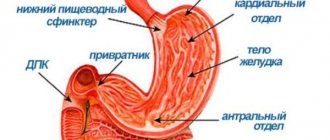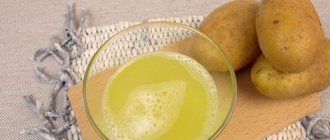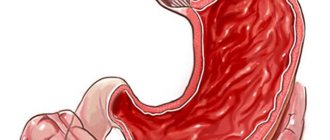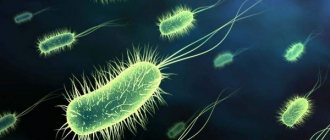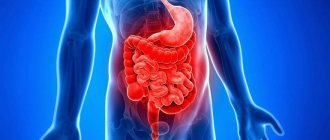What you need to know about the diet for antral gastritis
Antral gastritis is an inflammation of the part of the stomach immediately adjacent to the duodenum.
This department is most often exposed to various kinds of adverse effects. Firstly, it is in the antrum that the most favorable conditions are created for the proliferation of Helicobacter pylori, which causes inflammation and ulceration. This is due to the optimal level of acidity of gastric juice (pH from 3.0 to 6.0).
Secondly, the mucous membrane here is exposed to the irritating influence of bile thrown from the small intestine. And finally, the most dangerous drugs for the stomach (glucocorticoids and non-steroidal anti-inflammatory drugs) primarily damage the mucous membrane of the antral part of the organ.
Diagnostics
During gastrography with contrast in patients with antral gastritis, thickening of the relief folds in the pyloric region, spasm of the pylorus, segmented peristalsis, and disordered evacuation of gastric contents are noted. With FEGDS, spotty hyperemia of the mucous membrane, swelling of tissues in the antrum are visible, hemorrhages and erosions can be detected. There is increased exudation and stagnation of contents in the stomach due to spasm of the pylorus. During an endoscopic examination, a tissue biopsy is necessarily performed for histological examination and isolation of the pathogen. In this case, pronounced inflammation and a large number of Helicobacter on the surface of the epithelium are histologically determined.
The urease test for the determination of Helicobacter is carried out using special express kits during gastroscopy. To do this, a mucosal biopsy is placed in a special medium, which changes its color depending on the concentration of microorganisms to crimson - from an hour to a day. If the color does not change within 24 hours, the test is negative. There is also a C-urease breath test. To carry it out, C13-labeled urea is injected into the stomach, and then the concentration of C13 is determined in the exhaled air. If there are Helicobacter bacteria in the stomach, they will destroy urea, and the concentration of C13 will be above 1% (3.5% - mild invasion, 9.5% - extremely severe).
Mucosal biopsies must be cultured and incubated at extremely low oxygen concentrations (less than 5%) on blood media. The result of culture with sensitivity to antibiotics will be obtained within 3-5 days. ELISA is a fairly sensitive method for detecting antibodies to Helicobacter in blood, saliva and gastric juice. Antibodies appear in the blood within a month after infection and remain active for a month after complete recovery. To determine the acidity of gastric juice, intragastric pH-metry and fractional study of gastric juice using secretion stimulants are used. The disease is differentiated from functional disorders, gastric ulcer.
Do you need a diet?
Of course, therapeutic nutrition is not able to independently remove H. pylori from the body and completely eliminate duodeno-gastric reflux. However, no drug can fully demonstrate its effect when consuming “aggressive” food products. With increased stress on the stomach, there is often a need to take additional medications or increase their dose. And the irritating influence of spicy or fried foods significantly slows down the restoration of the mucous membrane.
Information. The main danger of antral gastritis is the increased risk of developing a cancer process in conditions of long-term inflammation (10 years or more). According to a European study by Sipponen et al., conducted on 370 patients, when the antrum is affected, the risk of developing gastric cancer increases by almost 9-32%. Women are more exposed to this danger.
As with other forms of gastritis, in the acute period of inflammation of the antrum, the most gentle table No. 1a is recommended. After a couple of days, they usually switch to a higher-calorie diet No. 1b. Since antral gastritis, as a rule, is associated with increased acidity of gastric juice, after stabilization of the condition, table No. 1 is prescribed. If inflammation persists for many years and the mucous membrane atrophies, then the secretion of hydrochloric acid may decrease. In this case, diet No. 2 is recommended.
Identification of the disease
To detect antral gastritis use:
- Patient interview. The doctor examines the patient’s symptoms, on the basis of which a preliminary diagnosis is made.
- General and biochemical blood tests. They help detect signs of inflammation (increased ESR and leukocyte levels), symptoms of liver and pancreas damage.
- Examination of a sample of gastric juice. Aimed at identifying Helicobacter pylori, considered the main cause of gastritis. This method may be replaced by a breath test, blood test, or stool test. The latter makes it possible to determine the genotype of the bacterium and select an antibacterial agent.
- Endoscopic examination of the mucous membranes of the stomach. Helps determine the location and severity of pathological changes and take a tissue sample for histological examination. In laboratory conditions, the type of cells that make up the material is determined.
- Ultrasound of the abdominal cavity. Prescribed if there is suspicion of malignant degeneration. The study is aimed at determining the size and location of the tumor.
- PH-metry. The acidity level of the contents of the stomach and duodenum is measured. A probe equipped with electrodes is inserted into the stomach cavity. Measurements are taken on an empty stomach and after meals.
- Electrogastrography. Studying the electrical activity of the muscle fibers of the stomach helps to obtain information about the contractile activity of the organ. The sensors are installed on the anterior abdominal wall.
Main rules
The diet for antral localization of gastritis has characteristic features. After all, it must take into account all the unfavorable factors that worsen the condition of the mucous membrane of a given section.
- Meals are frequent (5-6 times a day) and not plentiful. Try not to overeat.
- Fatty, fried foods, foods that stimulate the production of gastric juice and bile, and also have a fixing effect are prohibited.
- Limit physical activity within an hour after eating - it can provoke the reflux of bile and pancreatic enzymes from the duodenum into the stomach.
- Remember the need for thermal and mechanical care. Give preference to dishes at room temperature or heated to 45-55°. Chew food thoroughly, and during an exacerbation, chop it.
- All nutrients and biologically active substances must be present in the diet in full. Calorie content should correspond to mental and physical activity. It decreases only during the period of exacerbation of the inflammatory process.
Diagnostics
The patient’s general condition is assessed, and a set of laboratory and instrumental diagnostic methods is prescribed to differentiate the disease from other pathologies. The main diagnostic procedures are:
- stool, urine, general and biochemical blood tests;
- fibrogastroduodenoscopy (FGDS);
- X-ray and ultrasound examination of the abdominal cavity;
- computed and magnetic resonance imaging;
- C-urease breath test, enzyme-linked immunosorbent assay (ELISA), culture of gastric contents for bacterial flora, determination of its sensitivity to antibiotics;
- tissue biopsy.
A stool test is done to detect blood particles or pieces of undigested food. A general and biochemical blood test will provide information on the content of fats and glucose, characterizing the processes of digestion and absorption of nutrients. The presence of an increased number of leukocytes, C-reactive protein, and an increase in the erythrocyte sedimentation rate (ESR) indicates an inflammatory process occurring in the stomach.
FGDS allows you to visually assess the condition of the gastric mucosa, its color, thickness, folds, and determine the presence or absence of scars and erosions. During endoscopy, it is possible to take a section of living tissue for a biopsy to identify atypical cells that indicate a malignant process and the growth of a possible tumor.
Ultrasound, X-ray, CT and MRI give a general idea of the position of the stomach in the body, its size and shape. The methods are useful in differential diagnosis.
What is possible and what is not
Let us briefly outline those products whose consumption for antral gastritis is quite acceptable. This:
- cereals (buckwheat, oatmeal, semolina);
- vegetable crops, mainly thermally processed (beets, carrots, melons, potatoes);
- pasta – limited;
- low-fat deli meats (rabbit, chicken, turkey, veal, beef tongue);
- dietary fish varieties (pike, pollock, perch, grenadier);
- puree soups, vegetable, cereal vegetarian soups or in weak broth;
- crackers, savory pastries;
- vegetable oils in limited quantities;
- fruits (sweet pears, apples, bananas, ripe persimmons);
- dairy and fermented milk products;
- marshmallows, marmalade, sweet puddings;
- liquid jelly, weak black tea, diluted fruit juices and smoothies.
Now let’s list the foods that patients with antral gastritis should avoid:
- some porridges (rice, corn, millet);
- a number of vegetable crops (radish, spinach, legumes, white cabbage, corn, radishes, turnips);
- mushrooms;
- fatty products of animal origin (duck or goose meat, lamb, pork, liver, kidneys);
- fish with high fat content (sturgeon, halibut, some types of herring);
- smoked meats;
- spicy, seasoning, rich soups, tomato, pea soup, borscht, cabbage soup in the classic version;
- nuts, dried fruits;
- fresh bread and pastries;
- sour fruits (citrus fruits, pomegranates, pineapples, peaches);
- chocolate, cakes, pastries, ice cream;
- thick jelly, strong tea, cocoa, coffee, carbonated, alcoholic drinks.
Menu for the day
To make it easier to understand how to implement all of the above recommendations into real life, we suggest that you familiarize yourself with the daily diet of a patient with antral gastritis.
Breakfast: whipped semolina porridge with cherries, diluted black tea.
Lunch: cottage cheese-banana casserole, still mineral water.
Lunch: oatmeal soup with meatballs, roast rabbit, apple compote.
Afternoon snack: oatmeal pancakes, milk jelly.
Dinner: shortbread pie with chicken and broccoli, marmalade, herbal tea.
Before bed: a glass of milk.
Recipes to note
There are usually no problems with first and second courses for gastritis - after all, there are few restrictions on vegetables, meat and fish. But with desserts and appetizers it’s usually more difficult. At first it seems that everything delicious is forbidden. Let's try to prove that this is not so. Healthy things can also be tasty, you just need to learn how to combine the ingredients.
Whipped semolina porridge with cherries
You will need:
- 4 tbsp. l. semolina;
- 200 g fresh cherries;
- 2 glasses of water;
- 3 tbsp. l. Sahara;
- 1.5 g vanillin.
How to cook:
- Remove pits from cherries.
- Pour water over the berries, add sugar and boil for 10 minutes.
- Remove the cherries and rub through a sieve.
- Pour semolina into the remaining fruit drink and add vanillin.
- Cook the porridge for about 5 minutes until thickened, stirring constantly.
- Cool the semolina and beat with a mixer together with the pureed berries until a light airy mass forms.
Oatmeal pancakes in a slow cooker
Ingredients:
- 125 g oat flour;
- 1 banana;
- 1 egg;
- ½ tsp. soda;
- ½ cup skim milk;
- 1 tbsp. l. Sahara.
Action plan:
- Mash the banana with a fork.
- Pour oatmeal into it and add an egg, stir.
- Pour in milk, add sugar and soda. Mix everything until you get a homogeneous dough.
- Preheat the multicooker by setting the “Baking” mode.
- Pour a tablespoon of batter into the center of the bowl and close the lid for 1 minute.
- Turn the pancake over and cook covered.
- You can serve pancakes with natural low-fat yogurt.
Diet for superficial gastritis for every day
Chronic superficial gastritis (non-atrophic gastritis, type B gastritis) is a form of chronic gastritis in which the inflammatory process spreads exclusively to the mucous layer of the stomach, without affecting the glands and muscle tissue of the organ.
The main symptoms of the disease are dull, widespread pain in the upper abdomen and discomfort when eating spicy or rough foods . Patients also complain of recurrent heartburn, nausea, sour belching and constipation.
The causes of the development of chronic superficial gastritis are poor nutrition, addiction to alcohol and smoking, stress, and concomitant diseases of internal organs. Separately, it is worth highlighting infection with the bacterium Helicobacter pylori , since this factor is the leading one among other etiological factors.
Chronic recurrent gastritis ultimately leads to structural changes in the mucous membrane , and then to atrophic gastritis - a serious disease that threatens the development of oncology.
Chronic gastritis is a long-term disease of the stomach, which is characterized by structural changes in the tissues of the mucous membrane and disturbances in the functioning of the organ. Superficial gastritis is a morphological form of chronic gastritis, characterized by flattening of the mucous layer of the stomach and activation of secretory function.
Forms of the disease
According to the nature of gastritis, it can be:
- Spicy. This form of the disease is characterized by the rapid development of the clinical picture and the presence of severe symptoms. It occurs due to short-term exposure to provoking factors on the human body.
- Chronic. The development of the disease takes a long period of time. Periods of exacerbation are followed by periods of calm. With chronic antrum gastritis, a large number of erosive and cicatricial defects, as well as altered areas of the epithelium, occur.
Depending on the morphological characteristics, gastritis is divided into the following types:
- Surface. It develops against the background of active activity of Helicobacter pylori. The microorganism disrupts the functioning of the glands that produce mucus and increases the acidity of gastric juice. Inflammation of the upper layers of the mucous membranes occurs without ulceration or scarring. The disease is accompanied by pain, heartburn and sour belching.
- Erosive. It is considered a complication of superficial gastritis. In this case, erosive defects appear on the surface of the mucous membranes of the stomach, affecting the glands. As the ulcers deepen, bleeding develops and the tissue becomes scarred.
- Hyperplastic. Areas of dense epithelium appear on the mucous membranes. The cells turn into cysts and polyps.
- Focal. Gastritis occurs in a chronic form, the inflammatory process covers large areas of the epithelium. Tissues lose their functions over time.
- Atrophic. The disease is characterized by complete degeneration of the gastric epithelium and cessation of the functioning of the glands. Digestion of food becomes impossible. Atrophic gastritis is considered a precancerous condition.
Basics of proper nutrition
Compliance with certain nutritional recommendations for gastritis is an important point in the treatment and rehabilitation of the patient. If the diet and nutrition regimen are not followed, drug treatment will not bring the desired effect. How should you eat if you have gastritis?
Basic nutritional rules for patients diagnosed with gastritis:
- Eat 5-6 times a day in small portions, taking equal intervals between meals.
- Have breakfast , lunch and dinner at the same time.
- Chew your food thoroughly . Do not swallow whole pieces - this will harm even a healthy stomach.
- Breakfast should be complete . Don't limit yourself to a glass of tea or juice.
- Give up the habit of eating on the go and dry . Organize your daily routine so that you have enough time to eat.
- Have dinner no later than 3 hours before bedtime .
- Give up alcohol and smoking - the worst enemies of the stomach.
- Eat only fresh foods .
- Always wash your hands before eating.
These rules are also relevant for people who do not experience stomach problems. The basics of a healthy diet are the best prevention of all diseases of the gastrointestinal tract.
What can you eat with superficial gastritis?
List of recommended products for superficial chronic gastritis:
- Meat . Low-fat varieties are preferred (turkey, chicken, veal, beef). Eat meat boiled or stewed in the form of soufflés, meatballs, and cutlets.
- Fish. Choose low-fat varieties (pike perch, pollock, cod). Steam or boil the fish. Options for dishes: cutlets, soufflé, meatballs.
- Soups. Cook soups in vegetable, weak meat or fish broth. It is important that all components of the soup are well cooked and chopped.
- Bread . You can eat dried white bread. Fresh baked goods, muffins and pastries should be avoided.
- Porridge. Well-cooked, mashed porridges made from semolina, rice, and oatmeal are allowed.
- Fruits and vegetables . Include in your diet those foods that are easy to digest and do not cause fermentation in the stomach. Allowed vegetables are potatoes, carrots, beets, zucchini, pumpkin, cauliflower. Fruits should be consumed in the form of mousses, jellies, and compotes. Soft fruits, such as bananas, can be pureed and eaten fresh. Apples can only be eaten baked without the skin. You should not eat sour fruits and berries - citrus fruits, beak, lingonberries, etc.
- Milk and dairy products . Low-fat cottage cheese, fresh milk in limited quantities (it is preferable to add it to dishes), fresh (no longer than 1-2 days from the date of production) fermented milk products, sour cream, butter are allowed.
- Marshmallows, marshmallows, marmalade. Can be consumed in very moderate quantities outside the period of exacerbation.
Follow the principles of mechanical, thermal and chemical sparing of the stomach! In the acute period and during the recovery period, the above nutritional recommendations must be strictly followed. With the onset of remission, the list of products gradually expands.
What you can't eat
List of prohibited foods for superficial chronic gastritis.
- Fatty meats ( pork, lamb) .
- Fatty fish (salmon, chum salmon, beluga, mackerel, halibut).
- Soups with rich, strong meat, fish or mushroom broths.
- Porridge made from pearl barley, millet, and wheat groats.
- Fresh bread , bread with added bran, baked goods, pastries.
- Some vegetables and fruits . Vegetables that have a coarse fibrous structure and cause fermentation in the stomach are prohibited - white cabbage, turnips, radishes, radishes, onions, sorrel. Fruits that should be excluded from the diet are citrus fruits, pomegranates, grapes, kiwi.
- Legumes.
- Canned food , smoked meats, pickles, marinades.
- Chocolate and all products based on it.
- Store-bought sauces - mayonnaise, ketchup, mustard, etc.
Features of the diet for antral gastritis
Statistics show that stomach diseases are the most common among all diseases. The number of patients increases every year, and gastritis manifests itself in 50% of the population in a chronic form, and in 22% of people in other forms. Treatment of the disease is entrusted to the gastroenterologist, who determines the degree of development of the lesions and prescribes treatment and diet.
Without treatment, various forms of pathology and complications may develop. Diet for antral gastritis is the main form of overcoming the disease, which can be supplemented with other means to increase the effectiveness of therapy.
Principles of therapeutic nutrition
The diet for antral gastritis is aimed at restoring proper nutrition. To achieve the most effective treatment result for a type of erosive form of the disease, you need to adhere to certain rules for eating:
- frequent meals;
- small portions of food;
- compliance with the temperature regime of consumed food;
- chewing foods thoroughly;
- compliance with the water consumption regime;
- inclusion of chopped, pureed food in the diet;
- avoidance of foods that can cause mechanical, thermal, and chemical damage to the irritated walls of the stomach;
- course of medication.
A diet for superficial antral gastritis involves the use of folk remedies, for example, herbal infusions, decoctions, and vegetable juices. During the period of therapeutic nutrition, the consumption of alcoholic beverages and tobacco products is prohibited.
Overeating, fasting, and eating dry food should be avoided. Dietary nutrition is incompatible with heavy physical exercise, stressful situations, and lack of sleep. Treatment of pathology is compliance with the principles of eating, proper rest, and taking medications.
Features of antral gastritis
There are several types of gastritis. Any of them is caused by an inflammatory process occurring in the stomach, on the mucous membrane. With inflammation of the antrum of the gastrointestinal tract, erosive (antral) gastritis develops. Main causes of pathology:
- development of viral infections;
- bacteria;
- constant stress;
- frequent consumption of alcoholic beverages;
- smoking;
- improper use of medications leading to gastric disturbances.
Symptomatic signs of the disease
The antrum of the digestive organ is responsible for the production of substances that interact with hydrochloric acid during the digestion of food. When cicatricial deformities or gland lesions appear, the functioning of the stomach is disrupted. Signs of malfunctioning of the digestive tract are:
- severe pain;
- constant heartburn after every meal;
- bloating;
- belching;
- nausea;
- loose stools;
- lack of appetite;
- weight loss.
Serious disturbances in the functioning of the gastrointestinal tract begin to worry in severe forms of the disease. To avoid the progression of pathology, you should pay attention to the primary symptoms of gastritis.
Necessity of diet
Following a diet is important for complete recovery from gastritis. In order not to aggravate the course of the disease with other mistakes, it is worth understanding the rules observed while eating.
Rules for eating:
- I chew my food thoroughly. Do not allow large pieces of food, especially hard food, to enter the stomach.
- Do not be distracted by extraneous matters while eating to avoid mistakes.
- Add vitamin complexes containing vitamins PP, C, B6 to the main diet.
- Drink as much water as possible, preferably at least 1.5 liters per day. It is allowed to give preference to mineral water.
- Use infusions as an additional treatment. Chamomile tea, potato and cabbage squeezes, and fresh juices are suitable.
The recommendations listed above complement the diet and help to quickly cope with the disease. Chronic gastritis can be cured completely by following the above rules.
Diet for exacerbations of antral gastritis
It is advisable to bring food to a mushy state. You can eat cereals and liquid substances. Carbohydrates and foods rich in additives should be consumed minimally. There should be at least five meals a day, food is consumed in small portions. 2 hours before going to bed, eating any food stops.
The products from which food is prepared, in any form, should not negatively affect the walls of the stomach or increase the secretion of gastric acid. The diet after exacerbations is as follows:
- Cook semolina, pearl barley, and rice in water or low-fat milk. At the end, add a tablespoon of butter;
- You can only eat lean meat. It is advisable to eat it as a puree: a well-boiled piece of meat is ground with a grater, butter is added to it;
- Use a small amount of cream, milk, curd mass. Add honey, fruits, jelly with natural ingredients to your dishes to taste;
- The consumption of dietary dishes, chicken and quail eggs is allowed. Cook only with steam, make an omelet, boil. If possible, use homemade rather than store-bought products.
The preferred daily dish for one meal is jelly. The product is useful for any type of gastritis, not only antral. It will reduce the inflammatory process and promote rapid healing of damaged stomach walls. The main condition when preparing food during illness is to reduce the load on the digestive organs. Eat food in liquid form, in small portions.
Symptoms
The clinical manifestation of such a disorder is expressed only during an exacerbation of the chronic form; during the period of remission, a significant improvement in the person’s condition is observed, with insignificant expression or complete absence of symptoms. The following signs indicate an exacerbation of the disease:
- the occurrence of cramping pain in the stomach. Pain occurs on an empty stomach or several hours after eating;
- a feeling of discomfort in the form of pressure, heaviness and distension in the stomach;
- bloating;
- alternating constipation and diarrhea;
- attacks of nausea, which often end in vomiting. With erosive gastritis, in addition to food particles, the vomit contains blood impurities;
- belching and heartburn;
- the appearance of an unpleasant taste and odor from the mouth;
- loss of appetite, which leads to weight loss;
- severe weakness and increased fatigue of the body;
- a complete decrease in the immune system, which makes a person highly susceptible to colds and infectious diseases, which can complicate the course of the underlying illness.
Chronic antral gastritis is a rather dangerous condition. This is due to the fact that the affected walls of the stomach begin to change their structure, against the background of which the digestion process is disrupted. In addition, such a disorder can very quickly turn into an atrophic type.
Acidity level and nutrition for antral gastritis
If increased acidity of gastric juice is detected as a result of research, it is advisable to refrain from any flour products so as not to irritate the walls of the stomach. It is prohibited to eat fresh bread; you can only eat yesterday’s bread. Uneatable dough, baked goods, eat a maximum of once every 7 days. Eating pasta and vermicelli is allowed.
You can only eat non-viscous types of cereals. Oatmeal is irreplaceable for gastritis; pearl barley is not the best choice for high acidity of gastric juice. Ingredients for soups must be pureed. Meat only lean varieties. Steam the second dishes, keep the fat content to a minimum, and steam them.
Low acidity requires compliance with other food preparation rules:
- choose only the highest grade flour;
- eat bread slightly dried;
- Do not prepare soups from sour ingredients, do not add strong seasonings;
- for the second course, pancakes, some stewed meat, sausages, and low-fat fish are allowed;
- The consumption of fermented milk products in small quantities is allowed.
With antral gastritis, proper nutrition is not prohibited. It is enough to limit the consumption of some of the listed dishes. Rough foods are excluded: spicy, fatty, fried, high in fiber. Do not fry foods, but steam them and subject them to additional steam processing.
The attending physician must establish a list of prohibited products. Typically the list consists of the following items:
- Acidic liquids, berries, fruits. Raw vegetables.
- Fatty meats.
- Strong spices, sauces (mayonnaise, ketchup, mustard, wasabi, adjika and others).
- Alcoholic drinks, tobacco.
- Smoked meats, marinated dishes.
- Strong tea, coffee, chocolate, kvass.
- Yeast dough products.
Violating the prohibitions of the attending physician will cancel the effect of the therapy. The walls of the stomach heal over the course of several months, but the wounds can open in one meal of the wrong food.
Drug therapy
The drug treatment regimen for atrophic antrum gastritis includes:
- Antacids (Phosphalugel). The drugs reduce the acidity of gastric juice, giving an alkaline reaction. Under the influence of active substances, hydrochloric acid is converted into water. Taking the medicine helps get rid of burning and pain in the esophagus. If you abuse antacids, the activity of the acid-producing glands may increase.
- Histamine receptor blockers (ranitidine). They reduce stomach acidity, but the mechanism of action differs from that of antacids. Active substances act on receptors involved in the production of hydrochloric acid.
- Proton pump inhibitors (Omeprazole). They suppress chemical reactions during which protons are formed - components of acids.
- Protective agents (Gasterin). The drugs protect the mucous membranes from the effects of aggressive factors.
- Prokinetics (Metoclopramide). They improve the tone of muscle tissue in the upper sections of the digestive system, accelerate the evacuation of food masses from the stomach into the duodenum, and prevent the appearance of vomiting. The drugs are prescribed for gastritis caused by gastroesophageal reflux.
- Enzyme agents (Pancreatin). Contain substances produced by the stomach, duodenum and pancreas. Regular use of medications helps improve digestion, which is disrupted in atrophic forms of gastritis.
- Antibiotics. Eradication (elimination) of Helicobacter pylori infection helps to avoid the appearance of erosive defects and atrophic changes. Clarithromycin is used in combination with amoxicillin to kill bacteria.
Folk recipes in the fight against antaral gastritis
To increase the effectiveness of the remedies prescribed by your doctor, you can use traditional medicine recipes. The remedies relieve many stomach problems and are effective, including for antral gastritis.
Folk remedies for gastritis:
Potato juice is used to quickly relieve pain. Drink on an empty stomach, always freshly squeezed. One dose – half a glass, then lie down for speedy absorption.
- Flax seeds or oil for gastritis relieve stomach diseases and increase immunity. The seeds should be boiled for 5 minutes, 20 well crushed seeds per glass of water. Drink 1 tbsp. l. before meals.
- Drink 5 g of aloe juice 30 minutes before meals. The product helps to cope with stomach pain.
- Chamomile, elderberry tea, yarrow decoction, elderberry relieve stomach pain. Herbs may cause allergies; consult a doctor before use.
Features of the diet for antral gastritis
For antral gastritis, a gentle diet is prescribed; dishes should be easily digestible, without creating additional stress on the gastrointestinal tract or causing irritation of the mucous membranes. Basic Rules:
- It is forbidden to eat in a hurry, swallowing pieces of food without chewing them. It is very important to eat slowly and chew your food well;
- patients are advised not to be distracted while eating, not to watch TV, not to communicate on social networks, not to read the press or books;
- It is recommended to eat in small portions (250-300 ml), and the number of meals should be increased. It is necessary to sit down at the table 5-6 times a day;
- It is recommended to drink a lot of water, but not immediately after the patient has eaten, but after 40-60 minutes.
Advice! Patients are recommended to drink medicinal mineral water. The choice of water option is made after pH testing, that is, after determining the acidity level.
With high acidity
If the acidity of gastric juice is higher than normal, it is important to exclude all foods that stimulate secretory function. The list of permitted products includes the following products:
- yesterday's bread, unassembled rolls and pies (infrequently). Freshly baked bakery products and rich pastries are excluded;
- You cannot eat rich broths; soups are cooked in water, low-fat or diluted milk;
- Lean meat and white fish are best cooked minced. Frying is excluded; the dishes that make up the patient’s diet can be boiled, cooked in a double boiler, stewed, baked in foil or special bags. The use of foil is necessary to prevent the formation of a crispy crust;
- All sour fruits and berries are excluded.
Low acidity
If during the examination it turns out that antral gastritis occurs with a reduced level of acidity, then you need to add dishes to your diet that are easily digested without creating additional stress on the gastrointestinal tract:
- bread can only be eaten white and exclusively dried;
- soups can be cooked in broths, but low-fat ones. First courses that are cooked using tomato paste, sauerkraut, and pickles are excluded. So, you will have to give up cabbage soup, borscht and pickles;
- Fermented milk products are very useful, but whole milk in this disease can be poorly absorbed, causing rumbling in the stomach;
- meat dishes should be prepared from lean meat; you can use boiling, stewing and baking;
- Eating doctor's sausage and milk sausages is allowed, but not often;
- eggs can only be in the form of an omelet, boiled in a double boiler or soft-boiled. Hard-boiled eggs put stress on your stomach.
Erosive
Dietary nutrition for the erosive type of antral gastritis is a prerequisite for good health. Deviations from the diet can lead to a sharp deterioration and provoke a relapse.
The diet for the erosive form of antral gastritis should be gentle. Spicy, sour, smoked, fried foods are excluded from the diet. Carbonated water and any alcohol are prohibited.
Nutrition for the erosive type of antral gastritis should be regular and meals should not be skipped. It is important to prevent feelings of hunger; you need to eat every 2-2.5 hours, but in very small portions.
Chronic
In the chronic course of the disease, nutrition is adjusted taking into account the patient’s condition. If your health deteriorates due to an exacerbation of the disease, a strict diet is needed. Recommended:
As the condition improves, the diet is constantly expanding. It includes minced meat and fish, steamed, stewed vegetables, and baked apples. During the period of remission, restrictions are minimal. You should not eat fried foods with a hard crust, very fatty foods, or smoked foods. Alcohol and smoking are excluded.
Superficial
With superficial gastritis of the antrum in the initial stage, diet may be the only method of treatment. It is nutritional adjustments that can improve conditions even without the use of medications.
The diet for superficial antral gastritis should exclude dishes that have a negative effect on the mucous membranes and are difficult to digest. Porridges, soups with cereals or noodles in a weak broth, and stewed vegetables are recommended. Fruits can be eaten fresh (in small quantities), avoiding fruits with a sour taste.
Atrophic
The diet for atrophic gastritis of the antrum is made up of easily digestible dishes. Excluded:
- hot spices;
- products with sour taste;
- ready-made sauces (mayonnaise, ketchup, etc.);
- alcohol;
- marinades;
- salted and smoked fish;
- sausage and semi-finished meat products.
Etiology
The main cause of gastritis in general, and the antrum in particular, is the pathological effect of the bacterium Helicobacter pylori. The second most likely development factor is the complete absence or ineffectiveness of treatment for superficial gastritis. Other predisposing factors to the occurrence of exacerbation of the chronic course of such a disease are:
- Regularly taking certain medications without a doctor’s prescription or without following their dosage. They can negatively affect the gastric mucosa or reduce the level of immunity;
- constant consumption of hot and spicy foods, carbonated drinks and large amounts of table salt. It is for this reason that diet therapy is present in the treatment of this form of gastritis;
- maintaining an unhealthy lifestyle, addiction to alcoholic beverages, drugs or smoking;
- penetration of toxic or chemical substances into the body, for example, when working with them in hazardous industries;
- the course of infectious processes, for example, HIV or candidiasis;
- a wide range of vascular pathologies;
- diabetes;
- prolonged exposure to stressful situations;
- autoimmune diseases.
Under the constant influence of the above factors, the protective function of the mucous membrane decreases, causing it to be damaged by acid and the formation of superficial gastritis. If it is not treated in a timely manner, an erosive type of disease occurs, in which the formation of ulcers is observed on the inner surface of the stomach. All this entails the appearance of chronic antral gastritis.
Localization of antral gastritis
Authorized Products
For antral gastritis in the acute phase, the diet is quite strict. Allowed:
- slimy soups made from rice, semolina, oatmeal;
- boiled pasta, well-cooked porridge;
- some types of vegetables in the form of puree (potatoes, carrots, beets, broccoli, zucchini).
As you recover, lean fish and meat are introduced into the diet, first in chopped form, then in pieces. Steam or stew dishes in a small amount of water. For desserts, jelly, compote, a small amount of marshmallow, non-sour jam and honey are allowed.
Fruits and berries can be eaten raw, provided they are well tolerated; you need to choose non-acidic fruits.
Dishes for antral gastritis
When creating a weekly menu for a patient with gastritis, you need to adhere to the correct diet. Do not forget that dietary nutrition must be complete; it is important that the patient receives a sufficient amount of proteins, vitamins and other nutrients.
The main dishes for this type of disease are:
- a variety of porridges from well-cooked cereals;
- cereal, vermicelli or vegetable soups, they are prepared in water or weak broth;
- meat and fish dishes should be presented with steamed cutlets, meatballs, and quenelles. You can serve boiled fish or meat in pieces;
- fresh vegetables should be eaten in the form of salads. Vegetables can be used for stewing, making stews, purees, and casseroles.
So, with antral gastritis it is very important to follow a diet. A properly composed diet is one of the main conditions for recovery. You need to understand that even a one-time deviation from the diet recommended by a gastroenterologist can lead to a worsening of the condition. Therefore, you should not risk your health and give in to the temptation to eat something forbidden.
